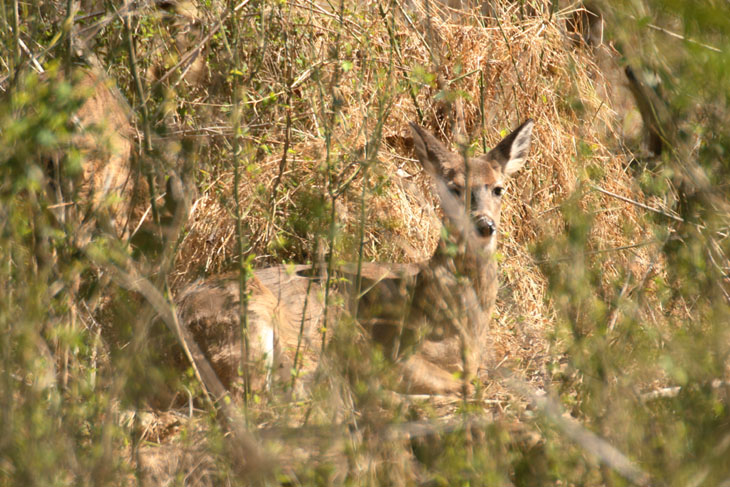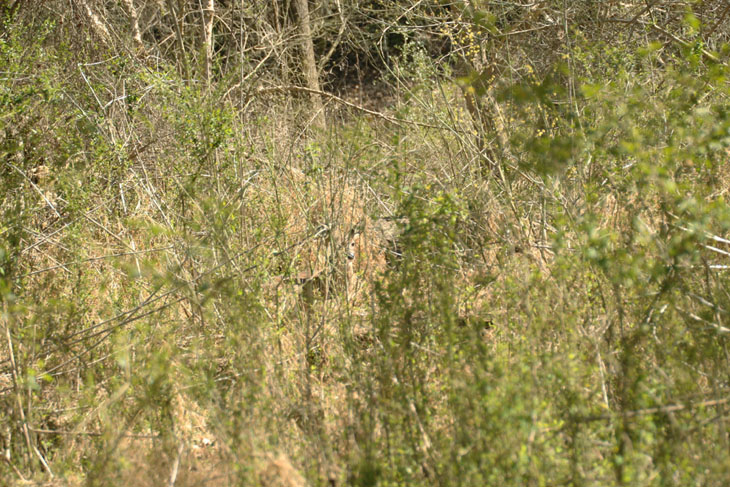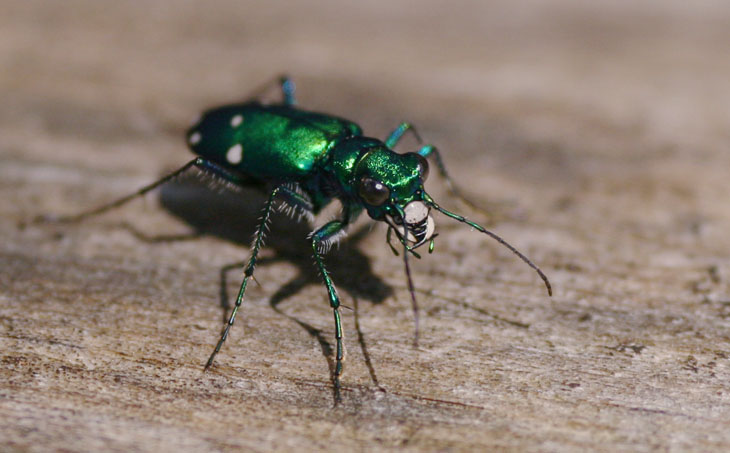I’ve been a little busy with various projects, which have kept me away from blogging, as well as failing to inspire any new topics or allowing me to tackle some of the posts in draft form that have been biding their time. So, for now, a few quick images from the past week.
On an outing on Tuesday, the same one that netted the image from the previous post, the incomparable Al Bugg and I chased a few deer – which is to say, we watched quietly as two white-tailed deer (Odocoileus virginianus) foraged rather unconcernedly a short distance away from us at Gold Park in Hillsborough. They were well aware of our presence, and even a few kids drumming their scooters along the slats of the boardwalk didn’t spook them off.

For as common as they are around here, I have far fewer quality pics of deer than I think I should. Sure, I get a few from time to time, but I should have dozens of shots, lovely portraits, action shots and all that jazz in my stock – shouldn’t I? But three things seem to happen surprisingly often (with full recognition that I might not be totally objective here): either they appear when I have no camera in hand, or they appear when I have the wrong lens attached and can’t do much about it without spooking them off, or they stand there obediently in absolutely crappy shooting conditions. Like these.

This one even lay down to bask for a bit, either cooperatively or to mock us, I’m not sure which. While I am very often using manual focus, mostly because the conditions I shoot in hamper autofocus from getting precisely what I want (and once it starts hunting, I ain’t gonna git nuffin,) there are limits to that too. With obscuring vegetation as seen here, it becomes very hard to pick a distinctive, high-contrast portion of the subject and pin that down, especially since none of the digital cameras I’ve used is geared towards manual focus, and their screens are only so distinct. Not to mention small – whenever I switch back to the film bodies I’m always delighted in how big and bright the viewfinder is in comparison. This shot seems fine for web use, but lacks the critical sharpness that I really want for my images.

I was using the Sigma 135-400mm lens for these, and this is backed off to 135mm focal length – still magnified a bit from what one would see without a camera, but giving a little more of an impression – the distance between us and the deer was ten to twelve meters or so, and really, this was the best vantage point available. Let’s just heave a heavy sigh together here and move on.
I saw a herd of deer the following day too, in fact I walked through the middle of them, which is to say, I was walking a path when the herd was crossing, and caught the first couple on the path itself. After they spooked off, I forged ahead to try and obtain a better vantage point, and the remainder of the herd, which I was unaware were waiting in the underbrush silently, darted across the path behind me. While I have a few photos, they’re really not at all worth putting up here. Make all the snarky comments you like.

The arthropods are starting to appear, including the first damselflies I’ve seen this season, mostly visible by the glitter of their wings as they fly. I still have plans to capture the emergence of the adults, as they molt their exoskeletons from the nymph stage, since I have no detailed sequences of this yet. The nymphs live in the water, and for the final instar they climb up reeds, lock their feet in place, and molt out as sexually mature adults, unfolding and drying out their wings. I’ve caught this not long afterward, but never in process yet.
 Not far away, also on the banks of the pond, I came across this quite large cocoon, the largest I’ve ever seen – it measures a good 10 cm (4 in) in length, not quite half that in diameter, and has a lovely rough paper texture. It seems likely this is the cocoon of a silkworm moth, Hyalophora cecropia (click on the Info and Images tabs at that link for more illustrations.) Hopefully, I can get my timing right on the emergence of this one too, because that should be a lovely sequence.
Not far away, also on the banks of the pond, I came across this quite large cocoon, the largest I’ve ever seen – it measures a good 10 cm (4 in) in length, not quite half that in diameter, and has a lovely rough paper texture. It seems likely this is the cocoon of a silkworm moth, Hyalophora cecropia (click on the Info and Images tabs at that link for more illustrations.) Hopefully, I can get my timing right on the emergence of this one too, because that should be a lovely sequence.
I spotted a large water snake as well, and have a shot of its midbody while the head was hidden in the grasses, but as I maneuvered around for a better vantage, it became aware of my presence and shot off into concealment. I often find it amusing how spooky people are of snakes, believing that the reptiles are going to launch themselves to the attack if anyone gets too close, since I frequently try to get as close as I can for pics and always watch the snakes hurtle away in terror – even when provoked, they can’t manage a decent attack. Still, I understand that phobias are irrational by definition – just don’t let them dictate defensive or abusive behavior.
I close with a six-spotted tiger beetle (Cicindela sexguttata,) a brilliant iridescent green species fairly common around here, hyperactive and sometimes hard to approach. A little patience allowed me to capture this portrait showing off those great predator’s mandibles. Also note that the eyes are actually shaped to give the appearance of glaring, instead of simply round, which to humans seems to indicate menace. It is, of course, just a physical trait on a visage that can’t change at all, but we can still appreciate the impression.

And, truth be told, tiger beetles are pretty aggressive – to other insects which it considers prey, anyway. I imagine that you might provoke a noticeable pinch if you grabbed one, too, but that’s only if you were lucky (?) enough to snag it before it flew away. From numerous attempts just to photograph them, I’d say you’d have a hard time accomplishing it. But don’t let me stop you from trying…



















































